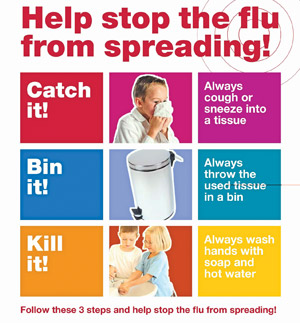|
Health Watch
Facts to be known:
Getting and giving flu
Dr. Shantha HETTIARACHCHI
The fever or flu is common to all of us. There is a famous saying in
Sinhala, una kaaraya vathura illanavaa vaage means, 'demanding for water
by a flu patient'. This implies that it is a problem not only to the
patient, but also to close family members.
|

Responsibility of the person who feels unwell |
The society should have basic knowledge on this common issue to avoid
possible complications of infection contacted and also in keeping away
from infection which is prevailing in the vicinity.
When a germ namely a bacteria, virus or parasite enters the body,
several protective mechanisms are activated. The body temperature goes
up with the entrance of these particles foreign to the body to develop
the state of flu or fever.
Fever
Fever is the oldest and most universally known distinctive feature of
a disease. It occurs in living being including, mammals, birds, reptiles
and birds. There are thermoregulatory mechanisms , activating to control
the body temperature. When there is an infection in the body, these
thermoregulatory mechanisms act as if they were adjusted to maintain
body temperature at a higher point than normal level that is a new point
above normal temperature, 37 degree celsius in human. As the result,
temperature receptors of the body signal that the actual temperature is
below the new set point which is established due to this infective state
and the temperature raising mechanisms are activated.
White blood cells
The monocytes, macrophages and kupffer cells are white blood cells in
the circulatory system. The toxins that are released from the germs such
as bacteria, viruses or parasites within the body will act on these
white blood cells to produce a chemical, called as cytokines. The
cytokines are also produced by cells in the central nervous system when
they are stimulated by infection. These cytokines act as endogenous
pyrogens in the body and responsible to provide a message to a tiny
hypothalamus, which is an endocrine gland , situated in the brain.
A special region which is called as the preoptic area of the
hypothalamus is stimulated by these cytokines to release a chemical,
prostaglandin. The prostaglandins, produced by the hypothalamus are
responsible in raising the temperature set point to develop fever or
flu.
Different type of viruses
It is not unusual in developing flu in close associates while the flu
patient is recovering from his illness. The main examples for these
situations are common cold and other flu conditions , caused by
different type of viruses by the way of droplet infection. When someone
is having these viruses in the body he can spread the infection to
others not only through coughing and sneezing but also with talking in
keeping with proximity. While talking to a person within 30 to 60
centimeter the virus may be released from the nose or mouth of the
patient to another new location.
|

fever or flu is common to all of us |
The released germs could be survived on the surfaces in external
environment for sometime. It is possible for someone to take these tiny
organisms into their hand through touching these surfaces without
knowing. If they touch their nose or mouth with unclean hands the
infective agent may enter the respiratory tract through the mucous
membrane of these sites.
Different types of viruses can cause fever. Of the common cold, which
occurs frequently among society, 30 percent to 50 percent cases are due
to infection with Rhinoviruses and 10 percent to 15 percent with Corona,
Adeno and Enteroviruses. Influenza viruses are also implicated with 5
percent to 15 percent cases of common cold.
When the body temperature goes up in one degree Celsius there will be
13 percent increase in metabolism and oxygen consumption. Consequently,
more energy is required by a person during the period of illness.
Therefore adequate rest is essential while maintaining good nutrition
with nutritious foods and plenty of fluids. It will help to recover from
illness without unnecessary delay and complications.
It is also a responsibility of the person, who feels unwell, having
high fever or sore throat to stay at home and keep away from work,
school or crowds in preventing spread of the infection to others. When
there is coughing or sneezing, the nose and mouth should be covered with
tissue paper or handkerchief. The hands must be kept clean by using soap
and water as there is a chance of contaminating the external surfaces
with the infective agents, residing there.
Recovery
Adequate rest, good nutrition, drinking plenty of water and using a
pain relieving drugs are adequate in recovering from most instances. If
the fever is continuing for more than three days or associated with
shortness of breadth or difficulty in breathing, it is necessary to seek
medical advice.
It should not be forgotten the ways of avoiding these infections,
while engaging in day to day activities. The ventilation of the living
space must be improved by opening the windows.
It must be kept in mind not to touch the nose or mouth with unclean
hands. Also, it is better to make a practice in cleaning the hands with
soap and water when there is a necessity and returning home. Adequate
sleep, exercises and good nutrition will help in curtailing these
illnesses in life.
H1N1
In time to time we have heard about dangerous flu epidemics or
outbreaks. The recent example for that was H1N1 novel influenza epidemic
in the year of 2009.
The most dangerous influenza flu epidemic was in 1918 in which 20 to
30 million people have been killed in the world.
Whether the flu is developed as a result of infection with a new
variant of viruses such as H1N1 influenza or viruses causing common
cold, there are no differences in the ways of prevention and avoiding
possible complications of the illness.
The responsibilities of the infected person to recover from the
illness without complication and to prevent the spread infection among
others are equally important as the responsibilities of the noninfected
person to get protected from the illness.
It is not a difficult task in living with minimal health problems if
the knowledge on good health practices are properly stored in our mind.
Chocolate lovers 'are more depressive',say experts
People who regularly eat chocolate are more depressive, experts have
found.
|

Chocolate |
Research in Archives of Internal Medicine shows those who eat at
least a bar every week are more glum than those who only eat chocolate
now and again.
Many believe chocolate has the power to lift mood, and the US team
say this maybe true, although scientific proof for this is lacking.
But they say they cannot rule out that chocolate may be a cause
rather than the cure for being depressed.
In the study, which included nearly 1,000 adults, the more chocolate
the men and women consumed the lower their mood.
Those who ate the most, more than six regular 28g size bars a month,
scored the highest on depression, using a recognised scale.
None of the men and women were on antidepressants or had been
diagnosed as clinically depressed by a doctor.
Mood food
Dr Natalie Rose and her colleagues from the University of California,
San Diego, say there are many possible explanations for their findings,
and that these need to be explored. It may simply be that people who are
depressed crave chocolate as a "self-treatment" to lift mood, or
depression may drive the craving without any beneficial effect.
"Alternatively, analogous with alcohol, there could be short-term
benefits of chocolate to mood with longer-term untoward effects," they
told the journal.
Chocolate could even be a direct cause of depression, the researchers
added.
Bridget O'Connell, of the mental health charity Mind, said: "The way
we feel and what we eat can be closely related, and many people will be
familiar with craving particular foods or comfort eating when they are
stressed, under pressure or depressed.
"However, as this study shows, more research is needed to determine
exactly what the relationship between chocolate and our mood is."
Menus with nutritional data helping consumers
In what will become a widespread practice, nutrition or calorie
labeling on restaurant menus is actually helping consumers be more
conscious and make better decisions about what they are eating. A 2008
New York mandate has put this into practice and the proof is in the
non-fat pudding.
|

Yummy but brings up a tummy |
The New York Department of Health and Mental Hygiene released initial
findings of an analysis on the impact of the city's menu-labeling laws.
Results indicate that consumers have become more selective in
choosing food with fewer calories. In fact, people purchased lower
calorie meals at 9 of 13 fast-food restaurant and coffee chains that
were included in the study.
To gather data, researchers began by surveying over 10,000 customers
at 275 locations during 2007, and then followed up with another survey
of 12,000 customers in 2009.
Findings revealed a significant reduction in calorie intake at four
chains including KFC, McDonald's, and Starbucks. Consumers who observed
the posted calorie counts purchased food that contained an average of
106 fewer calories compared to menu items bought by customers who did
not did not notice the postings.
A total of 56 percent of customers reported seeing calorie
information on the menus, while 15 percent of those say they used the
calorie information.
The researchers deemed their study more representative of consumer
eating habits than the earlier independent study, as it included a much
larger number of people and covered a much longer period of time.
The government study was also not limited to low-income neighborhoods
as was the case with the earlier study conducted by researchers from New
York and Yale Universities.
This study encompassed only 1,156 consumers and four restaurants
chains that included Burger King, KFC, McDonald's and Wendy's. The
analysis was performed over a period that began just prior to the 2008
mandate and continued to only just after the order was in place.
According to Lynn Silver, assistant commissioner for New York's
Bureau of Chronic Disease Prevention and Control, the government
findings suggest that consumers are both noticing the labels and taking
action.
In a statement, she said, "Dietary change is likely to come
gradually; it will start with consumers interested in making informed,
healthy eating decisions and we hope industry will respond by offering
more healthier choices and appropriate portion sizes." HEALTH NEWS |



